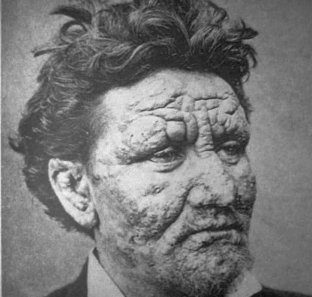Many infectious diseases, fortunately, no longer pose a threat to people, because in most regions of the world even the likelihood of their occurrence is completely controlled. But frequent and numerous tourist trips to the countries of Asia and Africa carry the risk of catching an infection, which our doctors meet irregularly and may not be sufficiently aware of its symptoms.
For example, residents of Brazil, South Asia, the Western Pacific, and East Africa can be infected with leprosy and pose a threat to many people in their environment. Often leprosy in the early stages is not distinguished from other dermatological problems, because its manifestations on the skin are not specific. How to recognize leprosy? What body rash is typical for leprosy?
What is leprosy?
Leprosy is a chronic infectious disease with a severe course, which is characterized by a polymorphic clinical picture and a long incubation period. The pathogenesis of leprosy is still largely unclear. It has been established that the contagiousness of the disease is small, but a patient with fresh leprosy is a source of infection, since he has a large number of leprosy mycobacteria. There are especially many of them in the mucous membrane of the larynx, nose and pharynx.
Infection with leprosy is likely after any contact with sinus secretions. Also, a leprosy stick can be found in such biological media as tears, semen, breast milk, urethral discharge, blood.
The main route of transmission of leprosy is airborne. The source of infection is a person with leprosy. Infection is also possible through household items that were in use by a patient with leprosy. Due to the low growth rate of mycobacteria, the incubation period is very long and can range from 1 to 15 years (average 5-7 years). The manifestations of leprosy depend on the type of disease.
There are 3 types of leprosy:
- lepromatous type of leprosy;
- tuberculoid type of leprosy;
- undifferentiated type of leprosy.

Clinical manifestations of the main types of leprosy
The clinical picture of leprosy is quite varied. skin, mucous membranes, lymph nodes and nerve trunks are involved in the process.
Lepromatous type of leprosy. The most severe form, accompanied by a variety of clinical manifestations. The skin and mucous membranes are often affected. The process involves lymph nodes, nerve columns, hearing organs, genitourinary organs, vision organs.
The clinic manifests itself slowly and almost imperceptibly - with the formation of a rash on the skin in the form of erythrematous spots of various sizes and shapes. The spots have a shiny surface. The rash is localized on eyebrows, on the forehead, cheekbones and earlobes. Less commonly, the process extends to the back surface of the hands and feet, buttocks, thighs, shins, forearms, torso.
Over time, an infiltrate appears at the site of the erythematous rash, and the elements rise above the level of the skin. A few years later, this rash turns into small nodules - lepromas. At the confluence of these lepromas, tumor-like, large-sized infiltrates are observed, which have an uneven, bumpy surface. With damage to the nasal mucosa, perforation of the nasal septum is possible.
Tuberculoid type of leprosy. This type of leprosy has a benign course. The skin and nerves are affected. Elements of a rash on the body – red-bluish flat bumps and papules. This rash can merge and form elements of different configurations. In the area of rashes, a violation of sensitivity is characteristic. Over time, the rashes thicken and peel off, and in their place an atrophic spot forms without signs of sensitivity.
Mycobacterium leprosy affects the nerve columns, notes estet-portal.com. Most often, the pathological process affects the ulnar nerve, which becomes painful on palpation. In the area of its innervation, the sensitivity is reduced. The tuberculoid type can become lepromatous.
Undifferentiated (borderline) type of leprosy. This type is unstable and lies between the lepromatous and tuberculoid types of leprosy, eventually becoming one of them.
The disease begins with the appearance of a small amount of unstable rash on the skin. The most typical area of localization is the buttocks, lower back, hips and shoulders. In the area of spots, sensitivity is lost, hair falls out, the process of sweating stops completely. So leprosy can last for a long time, while nothing else manifests itself. Such a course can last for years, without being accompanied by general noticeable health problems.
Quite often, atrophies of some muscle groups develop. With atrophy of the circular muscles of the eyelids , lagophthalmos develops. When the muscles of the face are affected, its maskiness is typical: the face takes on a sad and amimic look ("the mask of St. Anthony"). In later stages, due to thickening of the skin of the face against the background of infiltration, the face may take on the appearance of a "lion". The feet and hands are often deformed, acquiring the appearance of a "monkey's paw".

Aspects of diagnosis and treatment of leprosy
The general examination of the patient should be carried out in a sufficiently lit room so as not to miss hypochromic spots. After inspection, check their sensitivity. It is advisable to conduct a bacterioscopic study of scrapings from the mucous membrane of the nasal septum (but not mucus!). As a material for research, tissue fluid from a rash on the body and a punctate of enlarged lymph nodes are also used.
Leprosy must be differentiated from diseases such as skin tuberculosis, leishmaniasis and syphilis.
Until now, the treatment of leprosy raises a lot of questions, since there is no specific drug against it yet. A sulfonic drug, dapsone, is often used. Rifampicin and ethionamide are also used. Treatment is carried out in the clinic. The course of therapy for leprosy lasts about six months, then they take a break of 1 month, and in general the treatment is 3-3.5 years.
A person who has recovered from leprosy must be informed that he is now prohibited from working in the food industry and in child care.







Add a comment